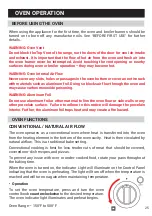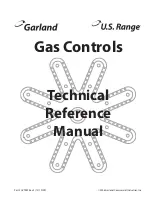
• Once the gas and power are connected, check that all range controls are in the “off”
position and turn on the main gas supply valve.
•
Check for gas leaks at all gas connections (using a gas detector, never a flame).
•
Check ignition of cooktop burners.
•
Check the flame. When properly installed, the flame will be steady and quiet and
approximately 1” in height.
COOKTOP OPERATION
BEFORE USING BURNERS
•
Select the cookware to match the burner. (Large Diameter = Large Burner, Small
Diameter = Small Burner)
•
Using oversized cookware may cause the flames to spread out and may cause
damage. The proper cookware size will also improve efficiency.
•
Cookware with a smaller diameter than the grate will not sit correctly, and this
creates a spillage hazard.
•
Only use heat-resistant cookware, marked safe for gas cooktops.
•
Thick cookware bases will give more even results, as hot spots are reduced due to
better heat distribution. Thin cookware bases will conduct heat faster but not as
evenly as thick cookware. Stir the food frequently to prevent burning.
•
Always place the cookware on the grate. The cookware must not be placed directly
on the burner.
• Use the following table as a guideline to which style burner is suitable for which cook-
ing style:
•
Check ignition of oven burner.
• Visually check heating elements of the oven. Carefully lift the panel on the interior
floor of the oven. Turn on the oven to check the heating element heats fully. Turn off
the oven and allow to cool before returning the floor panel.
• Visually check the broil heating element.
• Check operation of the convection fan.
IMPORTANT:
•
Metal components have a protective coating which may give off a slight odor the
first time your new appliance is heated.
•
The harmless odor will dissipate after a short time and does not indicate a faulty
connection or appliance defect.
21














































